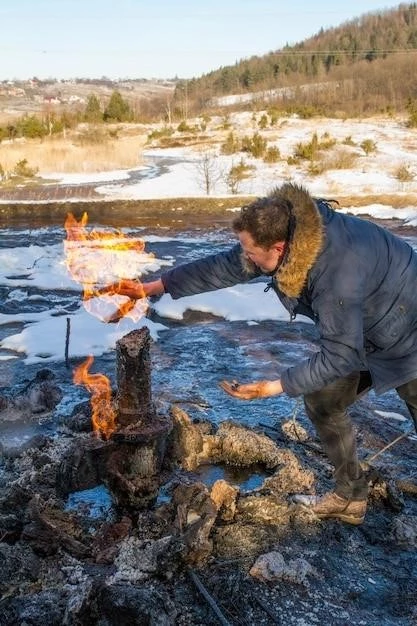Introduction to Pemphigus and Fogo Selvagem
The following information is written on the Internet today on a topic⁚ Fogo selvagem, also known as endemic pemphigus foliaceus, is an autoimmune blistering disease. It is essential to understand its unique epidemiological profile and clinical characteristics.
Overview of Pemphigus and Fogo Selvagem
Pemphigus and Fogo Selvagem are skin diseases with unique characteristics. Fogo Selvagem is prevalent in Brazil and other South American countries and is linked to poverty and malnutrition. The diseases involve autoimmune reactions and genetic predispositions alongside environmental triggers like black fly bites. The diseases present with specific lesions and can lead to complications if untreated. Diagnosis involves various tests, including skin biopsies and immunofluorescence. Treatment typically includes systemic corticosteroids and immunosuppressive agents, offering a good prognosis when promptly addressed.
Understanding Fogo Selvagem
Fogo Selvagem, also known as endemic pemphigus foliaceus, is an autoimmune blistering disease primarily affecting seborrheic areas. It is prevalent in Brazil and other South American countries, presenting unique epidemiological profiles.
Definition and Background
Fogo Selvagem, also known as endemic pemphigus foliaceus, is an autoimmune blistering disease that primarily affects seborrheic areas. With the highest number of cases in Brazil, particularly in the Central-West region, it shares immunological features with classic nonendemic pemphigus. The disease is characterized by the production of IgG autoantibodies targeting desmoglein 1, leading to skin blistering and acantholysis. Genetic factors, such as the HLA complex, and environmental triggers like black fly bites play a role in disease susceptibility and development.
Epidemiology of Fogo Selvagem
Fogo Selvagem, also known as Brazilian Endemic Pemphigus Foliaceus, primarily affects seborrheic areas in Brazil and other South American countries. The highest number of cases is reported in the Central-West region of Brazil, correlating with poverty and malnutrition. The disease’s prevalence near rivers and streams indicates a potential environmental trigger related to black fly bites, highlighting the importance of genetic predisposition and autoimmune mechanisms in disease development.
Link to Poverty, Malnutrition, and Environmental Factors
Fogo Selvagem, also known as Brazilian Endemic Pemphigus Foliaceus, shows a significant correlation with poverty and malnutrition, predominantly affecting regions near rivers and streams. Environmental factors such as black fly bites may trigger the autoimmune reactions leading to the disease development. Understanding these connections is crucial for effective management and prevention strategies.
Pathophysiology of Pemphigus and Fogo Selvagem
Fogo Selvagem, also known as Brazilian Endemic Pemphigus Foliaceus, is an autoimmune blistering disease affecting seborrheic areas. It involves pathogenic IgG autoantibodies targeting desmoglein 1٫ causing acantholysis and blistering. Genetic factors like HLA complex and environmental triggers like black fly bites play roles in disease onset.
Autoimmune Mechanisms Involved
Fogo Selvagem, also known as Endemic Pemphigus Foliaceus, showcases a complex autoimmune response targeting desmoglein 1 with IgG autoantibodies, causing skin detachment and blister formation. This intricate process involves genetic predispositions and potential environmental triggers, emphasizing the importance of understanding the immune dysregulation at the core of the disease.
Role of Immunoglobulin G4 (IgG4) Antibodies
In the context of Fogo Selvagem, IgG4 antibodies play a crucial role as they target desmoglein 1, causing acantholysis in the epidermis leading to blister formation. Understanding the significance of these autoantibodies is key in determining the pathophysiological mechanisms underlying the disease.
Clinical Presentation and Diagnosis
Endemic pemphigus foliaceus, known as Fogo Selvagem, presents with characteristic skin lesions, often starting in seborrheic areas. Prompt diagnosis through skin biopsies and immunofluorescence testing is crucial to differentiate this autoimmune blistering disease from other conditions. Complications may arise if left untreated, highlighting the importance of timely medical evaluation.
Classic Lesions and Progression
Fogo Selvagem (or Brazilian endemic Pemphigus Foliaceus) typically manifests with superficial blisters or vesicles in seborrheic areas, gradually progressing over weeks to months. It is crucial to recognize these distinct skin lesions for accurate diagnosis and timely intervention to prevent potential complications.
Complications and Diagnostic Criteria
Untreated Fogo Selvagem can lead to severe complications such as widespread skin detachment and infection, emphasizing the importance of early diagnosis. The diagnostic criteria include characteristic skin lesions, positive Nikolsky sign, skin biopsies showing acantholysis, and immunofluorescence tests revealing IgG autoantibodies. Prompt medical attention is crucial to prevent complications and ensure effective management.
Histological Findings and Diagnostic Tests
Endemic pemphigus foliaceus, known as Fogo Selvagem, typically presents with characteristic skin lesions in seborrheic areas. Diagnosis involves skin biopsies to detect acantholysis and immunofluorescence testing to identify IgG autoantibodies, ensuring accurate differentiation from other skin conditions. Early diagnosis is crucial for effective treatment and management.
Skin Biopsy and Acantholysis
Diagnosing Fogo Selvagem typically involves a skin biopsy to observe acantholysis, where epidermal cells detach. The presence of this phenomenon, alongside immunofluorescence tests highlighting IgG antibodies, aids in confirming the autoimmune nature of the disease.
Direct Immunofluorescence and ELISA Testing
In the context of Fogo Selvagem, direct immunofluorescence testing plays a crucial role in identifying specific antibodies targeting skin proteins. Simultaneously, ELISA testing aids in detecting autoantibodies in serum samples, providing valuable diagnostic insights to differentiate this autoimmune blistering disease from other skin conditions.
Approaches to treating Fogo Selvagem may include systemic corticosteroids and immunosuppressive agents. Prognosis and management strategies are crucial for effective disease control and patient well-being.
Treating Fogo Selvagem usually involves the utilization of systemic corticosteroids and immunosuppressive agents. These treatment modalities play a pivotal role in managing the disease and improving patient outcomes by targeting the autoimmune response responsible for blister formation.
Treatment Approaches for Fogo Selvagem
Systemic Corticosteroids and Immunosuppressive Agents
The treatment of Fogo Selvagem typically involves systemic corticosteroids like prednisone and immunosuppressive agents, aiming to control the autoimmune response causing blister formation. These medications are essential for managing the disease effectively and improving patient outcomes.
Stay informed about the latest advancements in pemphigus medications, including new treatments and therapies. Keeping up with research developments can provide valuable insights for optimal disease management and patient care.
Research and Developments in Pemphigus Medications
Stay informed about the latest advancements in pemphigus medications, including new treatments and therapies. Keeping up with research developments can provide valuable insights for optimal disease management and patient care.

Comparison with Other Autoimmune Blistering Diseases
When comparing Fogo Selvagem with other autoimmune blistering diseases, it is essential to understand the distinct clinical and immunopathological features that differentiate it from conditions like pemphigus vulgaris or mucous membrane pemphigoid. Consult a dermatologist for accurate diagnosis and tailored treatment options.
Distinctions from Similar Skin Conditions
When differentiating Fogo Selvagem from other skin conditions such as pemphigus vulgaris or mucous membrane pemphigoid, pay attention to the unique clinical and immunopathological features. Consulting a dermatologist is crucial for accurate diagnosis and tailored treatment plans.
Preventive Measures and Lifestyle Recommendations
Adopting good skincare practices, maintaining a balanced diet, managing stress, and avoiding potential triggers are essential for preventing and managing Fogo Selvagem. Consult with healthcare providers for personalized advice on lifestyle modifications.
Strategies to Manage and Minimize Risks
Implementing regular skincare routines, maintaining a balanced diet, managing stress effectively, and avoiding potential triggers are essential strategies for reducing the risks associated with Fogo Selvagem. It is vital to seek guidance from healthcare professionals for personalized recommendations on risk mitigation and lifestyle modifications.
Understanding the genetic predisposition to diseases like Fogo Selvagem is crucial for assessing individual susceptibility. Genetic factors, such as HLA complex alleles, play a significant role in the onset and development of autoimmune conditions. Consulting a healthcare provider can provide insights into personalized risk assessment and disease management strategies.

Impact of Genetic Predisposition on Disease Susceptibility
Genetic predisposition plays a crucial role in disease susceptibility, particularly in understanding conditions like Fogo Selvagem. The presence of specific alleles within the HLA complex can influence an individual’s likelihood of developing autoimmune diseases. Consult with healthcare professionals for personalized insights into genetic predisposition assessment and disease management strategies.
Environmental Triggers and Hypotheses on Disease Development
Environmental triggers like black fly bites and hypotheses surrounding salivary proteins play key roles in the development of diseases like Fogo Selvagem. Understanding these factors can lead to better preventive measures and management strategies. Consult with healthcare providers for personalized advice.
Involvement of Salivary Proteins and Black Fly Bites
Research suggests that environmental triggers like black fly bites, potentially introducing salivary proteins, play a role in initiating the autoimmune response seen in Fogo Selvagem. Understanding these environmental factors is essential for effective prevention and management strategies. Consult with healthcare providers for personalized insights.
Understanding the global distribution and incidence rates of diseases like Pemphigus and Fogo Selvagem can provide valuable insights into the prevalence of these conditions in different regions. Stay informed about the demographic patterns and affected populations to enhance awareness and preparedness for potential outbreaks.
Global Distribution and Incidence Rates of Pemphigus and Fogo Selvagem
Understanding the global distribution and incidence rates of diseases like Pemphigus and Fogo Selvagem can provide valuable insights into the prevalence and affected regions, helping raise awareness and allocate resources effectively. Stay informed about the demographic patterns to enhance preparedness and support for those impacted by these conditions.
Collaboration with Dermatologists and Healthcare Providers
Collaborating with dermatologists and healthcare providers is essential for accurate diagnosis, personalized treatment plans, and ongoing support for individuals affected by Pemphigus and Fogo Selvagem. Seek timely medical advice for optimal care and management of these autoimmune blistering diseases.
Regions Affected and Demographic Patterns
Fogo Selvagem, predominantly found in Brazil’s Central-West region, has also been reported in other South American countries. The disease commonly affects individuals in rural areas, with a higher incidence in children and young adults. Understanding the demographic patterns and the regions affected is crucial for enhancing awareness and implementing appropriate measures for disease management.
Educational Resources and Support for Patients
Access educational resources to learn more about Pemphigus and Fogo Selvagem. Seek support from healthcare providers for personalized guidance and assistance in managing these conditions effectively.
Initiatives for Raising Awareness and Providing Assistance
Efforts to raise awareness about Pemphigus and Fogo Selvagem are crucial for early diagnosis and timely treatment. Various initiatives focus on educating the public, offering support to affected individuals, and improving access to healthcare resources. By participating in these initiatives, individuals can contribute to a better understanding of these autoimmune blistering diseases and help enhance overall support and assistance for patients.
Conclusion and Future Outlook for Pemphigus and Fogo Selvagem
As research progresses, the understanding of Pemphigus and Fogo Selvagem improves, leading to enhanced diagnostic tools, treatment options, and support mechanisms. Collaborating with healthcare providers and staying informed about advancements in the field can positively impact patient outcomes. By raising awareness and fostering continuous research, the future outlook for individuals affected by these autoimmune blistering diseases is promising.
